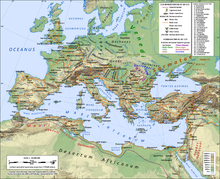Cotini
- Cotini
-

L’Empire romain sous Hadrien (117–138) montrant la localisation des Cotins, tribu celtique du nord de la chaîne des
Carpates.
Les Cotini ou Cotins étaient une tribu celte occupant probablement l’actuelle Slovaquie, et (selon certains) la Moravie et le sud de la Pologne. Ils constituaient probablement une part archéologique significative de la culture de Púchov avec son centre à Havránok.
La tribu a été mentionnée pour la première fois en 10 av. J.-C. dans l’Elogium de Tusculum. Selon Tacite, autant les Sarmates (qui peuplaient l’actuelle Ukraine) que les Quades (habitants de l’actuel sud-ouest de la Slovaquie, et l’est de la République tchèque) imposaient un tribut aux Cotini au Ier siècle ap. J.-C., lesquels le payaient grâce à l’exploitation de leurs mines de fer[1].
Les Cotini sont plus tard mentionnés en relation avec les guerres marcomanes. Vers 172, ils n’aident pas les Romains dans leur bataille contre les Marcomans. Pour les punir, Marc Aurèle transfère tous les Cotini en Pannonie inférieure, ce qui se produisit au plus tard vers 180. En Pannonie inférieure, ils sont mentionnés comme « cives Cotini » — le peuple des Cotini — en 223-251.
Notes
- ↑ Tacite, Mœurs des Germains, XLIII.
(en) Cet article est partiellement ou en totalité issu de l’article en anglais intitulé « Cotini » (voir la liste des auteurs).
Wikimedia Foundation.
2010.
Contenu soumis à la licence CC-BY-SA. Source : Article Cotini de Wikipédia en français (auteurs)
Regardez d'autres dictionnaires:
Cotini — The Roman empire under Hadrian (ruled 117 38), showing the location of the Cotini Celtic tribe in the northern Carpathian mountains Cotini was a Celtic tribe most probably living in today s Slovakia, and (according to occasional opinions) in… … Wikipedia
Dacians — See also: Dacia, Getae, and Thracians Statues of Dacians surmounting the Arch of Constantine[1] (i.e. southern side, left) The Dacians (Latin … Wikipedia
Dacian language — Dacian Spoken in Romania, northern Bulgaria, eastern Serbia; also (possibly): Moldova, SW Ukraine, eastern Hungary, southern Bulgaria, northern Greece, European Turkey, NW Anatolia (Turkey) Extinct probably by the 6th century AD … Wikipedia
Marcomannic Wars — Part of the Roman Germanic Wars Date 166– 180 AD Location Germania along the Upper Danube, Pannonia and Dacia … Wikipedia
Guerres marcomanes — Statue équestre de Marc Aurèle (Musée du Capitole, Rome), dédiée en 176 à l occasion du triomphe sur les Germains et les Sarmates Informations générales … Wikipédia en Français
History of Slovakia — This article discusses the history of the territory of Slovakia. Prehistory Palaeolithic Radiocarbon dating puts the oldest surviving archaeological artifacts from Slovakia found near Nové Mesto nad Váhom at 270,000 BCE, in the Early Paleolithic… … Wikipedia
Sarmatians — Infobox Ethnic group group=Tnavbar header|Sarmatians|Scythians poptime=Unknown popplace=Eastern Europe Central Asia Northern India langs=Scythian language rels=Animism related= *Sarmatians *Dahae *Sakas *Indo Scythians *MassagetesThe Sarmatians,… … Wikipedia
Banská Štiavnica — Geobox | Settlement name = Banská Štiavnica category = Town image caption = Trojičné námestie in Banská Štiavnica symbol = Banska Stiavnica CoA.png etymology = official name = motto = nickname = country = Slovakia country state = region = Banská… … Wikipedia
Volcae — The Volcae were a Celtic tribal confederation constituted sometime before the Gallic raid of combined Gauls that invaded Macedon in the 270s and defeated the assembled Greeks at the Battle of Thermopylae in 279. Though our view of Celtic tribal… … Wikipedia
Havránok — is an important archaeological site in northern Slovakia. It is located on a hill above the Liptovská Mara water reservoir around 2 km from the village of Bobrovník, about halfway between Ružomberok and Liptovský Mikuláš in the Liptov region. The … Wikipedia
 L’Empire romain sous Hadrien (117–138) montrant la localisation des Cotins, tribu celtique du nord de la chaîne des Carpates.
L’Empire romain sous Hadrien (117–138) montrant la localisation des Cotins, tribu celtique du nord de la chaîne des Carpates.
